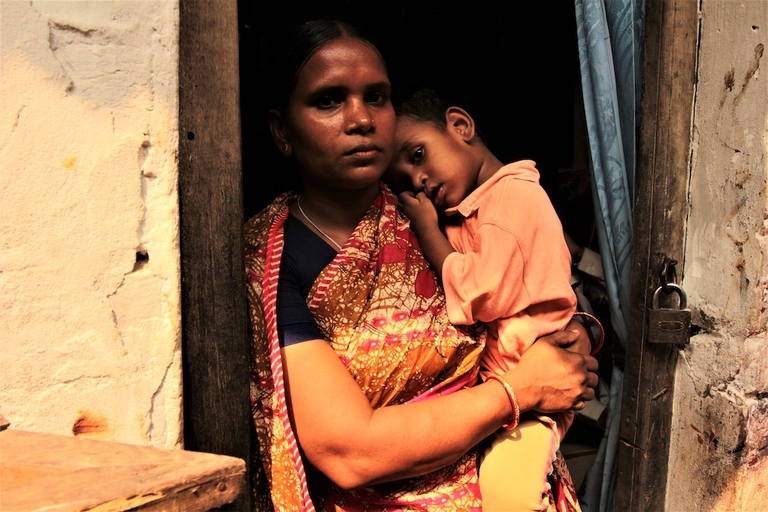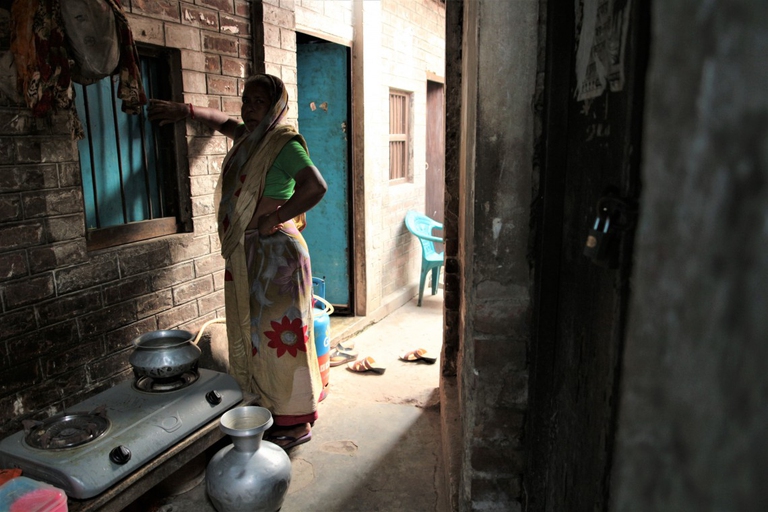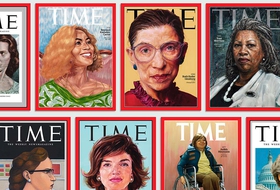
One in three women have suffered physical or sexual violence. With contributions from Europe, Africa, Asia and Latin America, we look at how this shadow pandemic affects every corner of the world.
Bangladeshi brothels like those in Faridpur are prisons with invisible doors in which women are forced into a vicious cycle of slavery and social exclusion. Whose chains are hard to break.
“I don’t often use make-up, I asked a friend to lend me hers. I felt good today, so I decided to wear some”. A smile lights up Tompa’s face as she looks at herself in a small mirror hanging on the wall of her room. “I make around 3,000 taka (35 dollars) a day. I wake up early in the morning, take a shower and put myself on display for the customers – she smiles softly –. They like me and are happy to come into my room. They come here for an hour but stay longer”. Tompa is one of the nearly 700 prostitutes who live in the Town Brothel and C&B Ghat Compound, the two brothels in Faridpur, city located in the homonymous province around 100 kilometres from Dhaka, the Bangladeshi capital. Tompa says she’s nearly 22 years old, but her face and mannerism betray a younger appearance. “I have customers every day. Sometimes one, sometimes two”. Tompa is young and beautiful, qualities that make her earn up to 1,000 taka (a little over 10 dollars) with a single client.
The Town Brothel is in the heart of the city centre. Opened during the colonial era, it’s more than a century old. It’s a maze of cement houses and corrugated iron roofs in which there are no toilets; the entrance is marked by a tattered jute cloth that leads onto a small alley. The little world made of modest homes and shops that live off the revenue generated by the brothel lies between small streets filled with garbage, which animals sift through. Young women dressed in coloured saris try to convince clients to come into their rooms as they walk around smoking or wait their turn, drink in hand.
Tompa’s room is in the middle of the brothel. Two four-storey buildings with dirty yellow walls dotted with small barred windows emerge from the sea of shacks, very similar to a prison. “I’ve been here for about two years, my partner sold me to a pimp for money – Tompa explains –. I have to give most of my earnings to my madame. Those who don’t hand over their share are beaten or locked in their rooms with no food for days”. Her stories on the methods employed by mesdames – the term used to describe the people, many older ex-prostitutes, exploiting the women – are terribly ordinary. Sex slaves in Bangladeshi brothels are often the victims of human trafficking taking place within the country.
On a population of 166 million, approximately 24 per cent of people, often from rural areas, live below the poverty line in Bangladesh, according to World Bank data. This is the context in which traffickers operate, alluring young women with the hope of a job and a better life. The victims are sold by their partners or families for little money, or in other cases are kidnapped, drugged and made to disappear.
The number of people trafficked, obliged into forced labour and sexual exploitation, is increasing in Bangladesh. The country was declassified in the 2018 US Office to Monitor and Combat Trafficking in Persons report, which defines it as “vulnerable” to this crime, stating that it’s not working effectively to contrast it. There are no certain figures on the number of victims but many, especially women, are sent to Gulf countries as well as the Middle East in general and Malaysia, others to the Indian state of West Bengal, whilst the remainder are kept inside the country. Bangladesh has instituted harsher penalties against traffickers, introducing the Prevention and Suppression of Human Trafficking Act in 2012. Notwithstanding the establishment of special courts, results have been modest. NGOs and international organisations warn that, whilst there are still thousands of victims every year, only one trafficker has as yet been convicted.
“The problem is that important and powerful people are involved in the trafficking system that manages the brothels,” states Hasina Akter Lovely, a lawyer that provides legal assistance to Faridpur prostitutes through the NGO Blast. It has become clear that the complicity and corruption of politicians, judges and the police play an important role in favouring the criminal network. “The women in the brothels live a truly miserable life – the lawyer adds –. They’re trapped, tricked by traffickers or betrayed by those close to them, and they aren’t aware of their rights. They’re tortured by mesdames to whom they have to pay the debt of their purchase. As if that wasn’t enough, they’re afraid to tell their families and the people back home about their condition because they risk stigmatisation and marginalisation. These women end up losing hope and getting them out of there is really difficult”. Prostitution is viewed very negatively in Bangladeshi society: for example, prostitutes are often denied burial and have also been the targets of attacks by religious extremists in the past.
Health concerns are also grave. The women often don’t even have enough money to eat, much less to afford healthcare, in the absence of adequate structures. They receive up to eight clients a day in order to survive, thus sexually transmitted diseases including HIV/AIDS are rampant. On the ground floor of the building that houses the brothel, 31-year-old Poli is cooking for her children; one is five and the other is two. “I’ve been here for a long time. They promised me I was going to be a housekeeper, but I ended up like this. I used to have an owner, I work independently now. I use the little money I make to pay for food and a place to stay, so I can’t pay for anyone to look after my children. I receive clients when they go out to play, or I make them sit over there…,” she says, whispering, pointing towards a stool just outside her door.
Shati is 20 years old, she’s holding her son, who she had from a client a few months ago. “Usually girls take drugs and drink because it helps them with the job. I don’t, because I don’t need to, just like I don’t use medicines. God gave me a healthy body so I don’t need them”. Drug dealers in the Faridpur Town Brothel mostly sell marijuana and yaba (pills, common throughout Southeast Asia, that contain a mixture of methamphetamine and caffeine) to prostitutes and mesdames, but when Shati speaks of medicines she alludes to another product: oradexon. This is a dexamethasone steroid used to treat illnesses such as arthritis and allergies, and is used in large doses by farmers to make livestock look plumper before being sold.
Used habitually, it’s a cheap and quick method to give the body shape, therefore attract more clients. But it’s proven to be addictive and has dire health consequences, especially affecting the liver and kidneys. The mesdames and pimps force girls to take it. In this way, gaunt bodies drained by malnourishment and fatigue, or those of skinny underage girls that have yet to bloom, are transformed to please customers. None of the sex workers we interviewed told us they were taking oradexon, but they all said they “know many who do”. Unsurprisingly, many empty blister packs can be seen in the rubbish around the brothel.
In 2000 Bangladesh became one of the few Muslim nations where prostitution is legal; according to various estimates there are currently between 140,000 and 180,000 sex workers aged 14 to 35 in the country. The law states that a woman can be a prostitute only if she’s of legal age and after signing an affidavit in which she declares she can’t find another job and is acting of her own free will. The Repression of Women and Children Act was put in place the same year, outlawing child and forced prostitution with severe penalties for clients and those exploiting victims, but the criminal system has found various ways to elude these norms.
“It’s pretty easy. Girls are sold by traffickers to exploiters and mesdames for 200 to 1,000 euros, depending on age, beauty and virginity. These people then force them to sign affidavits and corrupt authorities to declare they’re of legal age. That’s it,” explains Chanchala Mondol, president of the NGO Shapla, which works with the Faridpur prostitutes and their children. When describing the mental state of girls, she tells us that they work like slaves to pay back the mesdames: “Initially, their dream is to make it and be free once again, but they change their minds after a while”. In the end, after paying off their debt they stay on as independent workers, renting a room and hardly ever leaving the brothel. “They think they’re no longer part of society and no longer have a life,” Mondol concludes. A state of resignation that is brutally apparent in the dark alleys and rooms of Faridpur’s brothels. A condition of acceptance that rests uneasily with the dozens of fatherless children who play in front of the entrance to the neighbourhood. And most of all, a cycle that is extremely hard to break.
Siamo anche su WhatsApp. Segui il canale ufficiale LifeGate per restare aggiornata, aggiornato sulle ultime notizie e sulle nostre attività.
![]()
Quest'opera è distribuita con Licenza Creative Commons Attribuzione - Non commerciale - Non opere derivate 4.0 Internazionale.
One in three women have suffered physical or sexual violence. With contributions from Europe, Africa, Asia and Latin America, we look at how this shadow pandemic affects every corner of the world.
The Istanbul Convention against gender-based and domestic violence marks its tenth anniversary. We look at what it is, who its signatories are, and what the future might hold.
European Commission President Ursula von der Leyen reminded us of the gravity of violence against women around the world, and of the Istanbul Convention’s utmost importance.
President Erdoğan has pulled Turkey out of the Istanbul Convention, key in the fight against gender violence, claiming that it favours the LGBT community rather than family values.
Violence against women in Peru has increased as a result of Covid-19 lockdowns. 14,912 people were reported missing from January to November 2020, more than half of them minors and 64 per cent women. People have been confined to their homes for months, many forced to endure poor physical, economic and social conditions. A situation that
Joys Estefani Qqueccaño Huamani, 24, disappeared from her rural community in Peru on 9 October. Her family began looking for her independently of the authorities and despite the resistance of relatives of Joys Estefani’s ex-partner Arturo Ccana Condori, 32, charged with committing violence against her on 28 September, eleven days before Joys Estefani disappeared. Photos
Costa Rica celebrated its first same-sex marriage when two women, Alexandra Quiros and Dunia Araya, celebrated their wedding: an “extraordinary moment”.
The pandemic and its restrictions are affecting everyone, without exceptions. However factors like housing, income inequalities, gender, access to technology and working conditions are influencing how people experience the health crisis.
Time magazine’s 100 Women of the Year project sheds light on influential women’s stories, from Amelia Earhart to Greta Thunberg. A selection of some of the greats for International Women’s Day.










